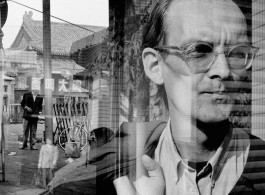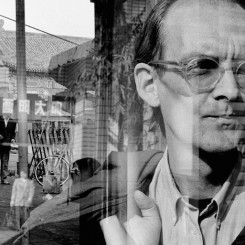A historical exhibition in two parts, co-commissioned by Ullens Center for Contemporary Art (Beijing) and Witte de With Center for Contemporary Art (Rotterdam), comprising documentary materials and artworks that examine the life and work of a defining figure in contemporary Chinese art.
Dutch-born, Beijing-based curator, scholar, and dealer Hans van Dijk (1946 – 2002) was a foundational influence on contemporary art in China. His myriad contributions include the seminal 1993 exhibition “China Avant-garde,” the first show of Chinese contemporary art in Europe; the New Amsterdam Art Consultancy (NAAC), which connected Chinese artists with collectors and curators abroad; and the China Art Archives and Warehouse (CAAW), an experimental gallery and exhibition space.
Based on extensive interviews and archival research, “Hans van Dijk: 5000 Names” considers his legacy as it looks at the major artists he championed and the scene they inhabited during the 1990s. The exhibition comprises three main elements grouped chronologically within significant periods in the scholar’s life. A collection of documentary material from Holland, Germany, and the NAAC/CAAW archive, Beijing, includes catalogues, personal correspondence, and photographs, recording in depth van Dijk’s life and work within an emergent art scene. Complementing these documents are works by Chinese artists with whom van Dijk worked closely. Van Dijk’s contribution to the introduction of photography as contemporary art into the Chinese and international art world will be looked at closely, and several historical works by figures including Li Yongbin and the New Analysts (Xin Kedu), originally included in van Dijk’s exhibitions, will be recreated. Together, these documents and works offer an immersive look into the world of a critical figure whose legacy has only just begun to be unpacked, reopening not only the conversation surrounding van Dijk and his manifold contributions to Chinese contemporary art, but the history of the 1990s in Chinese art and culture more broadly.
The final element of the exhibition is van Dijk’s life’s work: a meticulously organized, staggeringly comprehensive lexicon of over 5,000 Chinese artists born between 1880 and 1980, documenting the history of the country’s modern and contemporary art. The lexicon, discovered on van Dijk’s computer, is a groundbreaking document compiled over decades that details the exhibition and publication history of virtually every important Chinese artist of the twentieth century. As exhibition curator Marianne Brouwer notes, “There has been a longstanding awareness of Hans’ importance to the art scene in China—as a curator and a dealer, creating relations between art in China and the Western art system, particularly in the early nineties. Finding the lexicon has decisively changed the way in which we must consider his legacy. In this exhibition, we are showing a digital version that Hans created, though he also designed a book he meant to publish in print form. We are now well on our way to setting up a foundation to care for his legacy, and one of our first concerns will be to research the meaning of the lexicon and the possibilities of having it published.”
Hans van Dijk acted as a teacher, curator, dealer, and scholar in a time when art infrastructure in China was virtually nonexistent. He taught artists how to manage themselves and the minutiae of the art world: how to curate and have their shows curated, pack artworks, fill out loan forms, and show to local and international collectors. Critically, he was one of the first to view these artists within their larger context, both as a continuation of Chinese art history and as a part of international contemporary art practice. Van Dijk worked against predominant post-colonial attitudes, encouraging Chinese artists to see themselves as equal contributors to a global cultural dialogue.
Hans van Dijk was instrumental in launching the careers of many important artists and in generating early international interest in Chinese contemporary art. After studying Mandarin in Nanjing starting in 1986, during which time he traveled around China’s Jiangnan region visiting exhibitions and meeting artists, van Dijk returned to Holland in 1989. While there, he began promoting Chinese artists to a continental audience, culminating in the seminal “China Avant-garde” exhibition at Haus der Kulturen der Welt. Van Dijk returned to China in 1993 to immerse himself in the Beijing art scene, and in 1994 he founded the New Amsterdam Art Consultancy as an umbrella for his exhibitions, writing, and dealership.
The 1990s saw the scholar undertake many curatorial and business projects to mixed success. He organized several exhibitions of Chinese art in Europe, especially in Germany. Hans van Dijk helmed the Central Academy of Fine Arts Gallery for a mere six months in 1996, managing to put on six of the greatest shows of his career at a breakneck pace. In 1998 he co-founded the profitable China Art Archive and Warehouse, van Dijk’s first commercial venture, with Ai Weiwei and Belgian collector Frank Uytterhaegen. The Archive contains detailed information on more than 450 Chinese contemporary artists and thousands of documents on the history of van Dijk’s exhibitions both in China and abroad.
Yet these career triumphs were marred by frustration. Van Dijk was a mediocre businessman, more focused on what was vanguard than what was sellable. Official protest sank his landmark 1997 project “Face to Face,” a three-part collaboration with Siemens that would exhibit Chinese and German artists together. During the late 1990s, several of van Dijk’s closest artist friends left his stewardship for more commercially successful dealers, while an influx of foreign curators diminished his role in Beijing. Yet despite this, Hans remained a beloved mentor and leading academic for a generation of Chinese artists up until his death in 2002. As Wang Guangyi posited, “If Hans were alive today, his space still running, I think he would be the most important figure in contemporary Chinese art. Not as a dealer, no, but as a scholar, able to influence the entire discourse of art.”
This exhibition in two parts is curated by Marianne Brouwer and developed with Philip Tinari (Director, UCCA) and Defne Ayas (Director, Witte de With), together with Venus Lau (Curator, UCCA), Samuel Saelemakers (Associate Curator, Witte de With), and Ian Yang (Curatorial Fellow, Witte de With). Curatorial assistance was provided by Andreas Schmid and Zhang Li. The exhibition is co-commissioned by the Ullens Center for Contemporary Art, Beijing (24 May – 10 August, 2014) and Witte de With Center for Contemporary Art, Rotterdam (4 September, 2014 – 4 January, 2015).
The UCCA presentation of “Hans van Dijk: 5000 Names” is sponsored by Dior and the Embassy of the Kingdom of the Netherlands in Beijing. Research support for Marianne Brouwer was provided by the Mondriaan Fund.
Participating Artists
“Hans van Dijk: 5000 Names” includes artworks by Ai Weiwei, Big Tail Elephant, Cang Xin, Chen Shaoxiong, Ding Yi, Duan Jianyu, Thomas Fuesser, Geng Jianyi, Gu Dexin, Hai Bo, Han Lei, Hong Hao, Hong Lei, Li Yongbin, Lin Yilin, Liu Anping, Liu Ding, Luo Yongjin, Mai Zhixiong, Meng Huang, New Analysts, Qiu Zhijie, Shi Yong, Sun Kai, Hans van Dijk, Wang Shilong, Wang Xingwei, Wang Yin, Wu Shanzhuan, Xu Hongmin, Xu Tan, Xu Zhiwei, Yan Lei, Yu Youhan, Zhang Enli, Zhang Hai’er, Zhang Peili, Zhao Bandi, Zhao Shaoruo, Zheng Guogu, Zhou Tiehai, Zhu Fadong, and Zhuang Hui.”
About the Curator
Marianne Brouwer (b. 1942) is an art historian, curator, and writer, with a speciality in contemporary art. She was born in the Netherlands and has lived in Japan and France, where she obtained her MA in art history at the Sorbonne University, Paris. In the seventies she worked as an art critic and journalist. During the eighties and nineties she was the curator of sculpture at the Kröller-Müller Museum. She has published and lectured widely, participated in international juries, and taught at various art institutions.
In 1994 she curated the exhibition “Heart of Darkness,” dedicated to issues of exile and the Other with site-specific installations by Huang Yong Ping, Cai Guo-Qiang, and Gu Wenda (Kröller-Müller Museum, Otterlo, Netherlands). In 1997 she was the guest curator of the exhibition “Another Long March: Chinese Conceptual and Installation Art in the Nineties,” the first comprehensive exhibition of Chinese conceptual and video art outside China (Breda, Netherlands, 1997). In 2004 she received the Netherlands’ AICA (Association Internationale des Critiques d’Art) award for best exhibition and best book for “Dan Graham: Works 1965-2000.”
About the Ullens Center for Contemporary Art
The Ullens Center for Contemporary Art (UCCA) is an independent, not-for-profit art center serving a global Beijing public. Located at the heart of Beijing’s 798 Art District, it was founded by the Belgian collectors Guy and Myriam Ullens and opened in November 2007. Through a diverse array of exhibitions with artists Chinese and international, established and emerging, as well as a wide range of public programs, UCCA aims to promote the continued development of the Chinese art scene, foster international exchange, and showcase the latest in art and culture to hundreds of thousands of visitors each year.
http://ucca.org.cn/en/
About Witte de With Center for Contemporary Art
Witte de With Center for Contemporary Art is an international public institution with Rotterdam as its home base. Established in 1990, Witte de With explores developments in contemporary art worldwide. Witte de With has been commenting on the social and political predicament since its inception through the presentation of curated exhibitions, symposia, live events, educational programs, and a bold publishing arm.
www.wdw.nl


